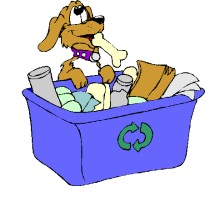- The
following information provides simple ideas for Consumers on how to recycle
and
- reduce waste and
so help you to protect our Natural Environment.
Supermarkets:
Many supermarkets sponsor Redemption Centers that will take back:-
- containers for recycling,
- steel and aluminum cans,
- glass bottles and jars and
- newspapers.
Some stores may have reverse vending machines, which give you money back
as used containers are fed into them.
Some Supermarkets also have a place to recycle:-
- used plastic
- grocery bags and
- film containers (plastic canisters that package the film).
- Why not bring your own reusable cloth shopping bags
instead
- or last weeks plastic bags?
And if you buy just one or two items, try going without a bag
altogether. The store pays for its bags, which means so do you, and
in the end, so does the environment.
Dry Cleaners
Many dry cleaners take back their plastic clothes bags. When you get
home and hang up your clothes, keep the plastic covers and recycle
them on your next trip to the dry cleaners -- rather than throw them
away. Some stores will also reuse clean hangers. Reusing By Donating
There are many items that even the most active recycler may throw
away because they are uncommon recyclables. Some of these items
include mattresses, furniture, clothing, appliances, electronics or
art materials. They can often be donated to local thrift stores and
non-profit groups to be repaired and reused. Source Reduction -- Make It Recyclable and Reusable
While shopping, you can help the environment by selecting products
that use less packaging and are reusable or readily recyclable in
your community. When buying a product, stop and think, "Can this
item be recycled or reused?" If not, is there an alternative brand
or product that you can buy? By making these choices, you are using
your purchasing power to reward manufacturers that make recyclable
and reusable products, not products that are only disposable.Try these reusable alternatives:
Use a sponge instead of throwaway wipes
Buy rechargeable batteries
Buy cloth napkins that you can wash instead of paper you throw away
Buy washable plates and cups for picnics instead of disposables
Buy razors with replaceable blades
Seek out reusable or refillable containers that hold shampoo, soap,
etc.
Use plastic containers with lids instead of aluminum foil, plastic
bags or plastic wrap
Rinse plastic bags and reuse them
Buy Products Made of Recycled Materials
No recycling program is truly successful unless:-
1. Recyclables are collected 2. Transformed into marketable products and then 3. Purchased by you! To create a demand for recycled products, make sure to purchase paper
(computer, stationery, legal, white, envelopes and newspaper) that
contain recycled materials. Ask store managers to stock products
made with recycled materials and write to the manufacturers of the
products you buy and tell them you prefer that they use recycled
materials.
When shopping, buy those items that say, "Made from recycled
materials" and have the highest percentage of post-consumer recycled
content. (Post-consumer content means any material that the public
has already used or recycled.) Beware, claims such as "environmentally
friendly", "eco-safe", "safe for the environment" or "natural" do
not necessarily mean that the product can be recycled or contains
recycled material!
Thanks to today's technology and manufacturing, these products are
as high a quality (if not higher) than products that don't contain
recycled materials, and they look just as nice. Look for these items
for your home or business in your community:
Clothing and shoes
Children's toys and playground equipment
Garden tools
Carpet and carpet pads
Plastic lumber for planters, decks and benches
Motor oil
Floors and countertops
Rain gutters
Packaging materials
Paper products like tissue and towels
Cleaning supplies
Writing or computer paper and envelopes
Your choices and efforts can make a significant difference in the
success of San Diego and our nation's recycling programs!

Avoid Excess Packaging and Buy In Bulk
While it's true that some packaging is necessary for health and
shelf-life considerations, all too many manufacturers over-package
their products. This excess packaging costs consumers more money;
costs our environment more resources and energy; and costs our
landfills valuable space.
So take a little extra care before you buy. Look for an alternative
product without packaging or the least amount of packaging and send
a message that you don't like waste. Also, avoid single-serving
items that are overly wrapped.
When it makes sense, buy in bulk, but only purchase the amount you
will use within a reasonable time. You will avoid over-packaging and
save money, since larger quantities are generally discounted. Try
these alternatives next time you shop:
Large box of cereal vs. individually wrapped snack pack of mini
boxes of cereal
Pudding in a box vs. pudding in plastic cups which are then held
together by a cardboard carton
Fresh vegetables you buy by the pound vs. shrink-wrapped vegetables
in Styrofoam containers
1-gallon water jugs vs. 6-pack of individual 12-ounce plastic
bottles
Condensed can of soup vs. microwavable single-portion soups
|